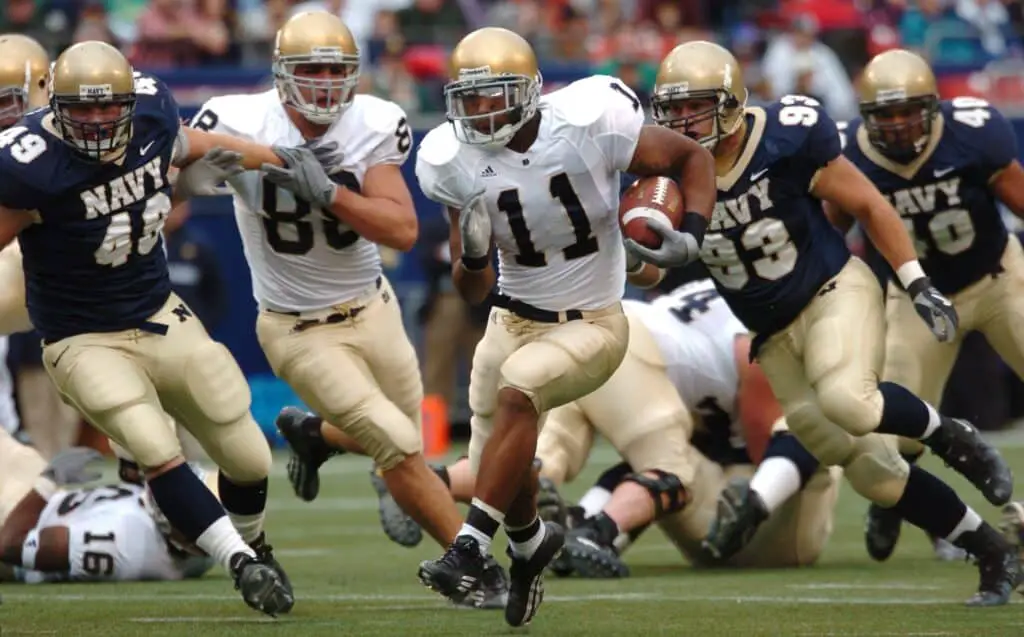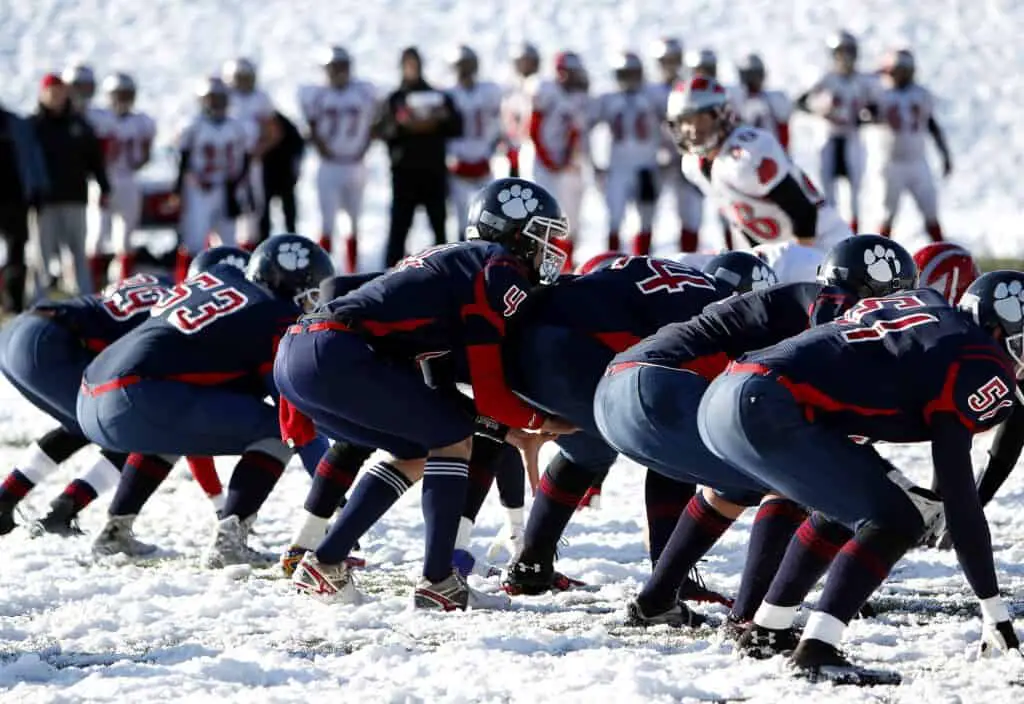Understanding what’s happening during football running plays is a lot simpler when you know who’s answerable for the running match-up. Whenever you see a football offense set up, search for the two players who line up in the hostile backfield (the territory of the field behind the quarterback and the line of scrimmage). These players are the running backs. The more modest one is the principle ball transporter, and the bigger one is the person accused of ensuring the ball transporter.
A running back (RB) is the situation of a player on an American football crew who generally lines up in the hostile backfield. The essential functions of a running back are to get handoffs from the quarterback for a surging play, to get passes from out of the backfield, and to hinder.
Click here to view and buy great American football gadgets.

There are generally a couple of running backs on the field for a given play, contingent upon the hostile arrangement. A running back might be a halfback (HB for short, in specific settings likewise alluded to as a tailback) or a fullback (FB).
Halfback/ Tailback
The halfback or tailback position is one of the more impressive situations on the field, as it is regularly fundamental in both the passing and running assault. A balanced halfback is normally seen as a prerequisite for a group’s prosperity. He is liable for conveying the ball on most running plays, and may often be utilized as a recipient on short passing plays. In the present game, a viable halfback must have a predominant mix of both speed and dexterity as a sprinter, just as sure hands and astute vision upfield as a recipient. An ever-increasing number of quarterbacks rely upon halfbacks as a dump-off recipient when essential targets downfield are secured. Incidentally, they line up as extra-wide collectors. When not serving both of these capacities, the essential obligation of a halfback is to help the hostile linemen in impeding, either to ensure the quarterback or another player conveying the football. On some uncommon events, running backs are utilized to pass the ball on a halfback choice play or halfback pass.

No situation in Canadian/American football can play out his obligations effectively without the assistance of different players. Like the wide receiver, who by and large can’t make enormous plays without the quarterback passing to him (except for the end-around or a converse), the running back almost in every case needs great hindrance from the hostile line to effectively pick up yardage. Likewise, a running back will for the most part have more hurrying endeavors than a beneficiary will have gatherings, which is predominantly because a collector must catch a pass to get a gathering, while a running back typically takes an immediate handoff or short pitch from the quarterback before enlisting a surging endeavor.
Note that the distinction between halfback and tailback is just the situation of the major part in the group’s hostile development. The halfback lines up roughly somewhere between the line of scrimmage and the fullback (correspondingly, quarterbacks line up a fourth of the separation between the line of scrimmage and the fullback). Since the halfback is normally the group’s principle ball transporter (while the fullback is essentially a blocker), numerous mentors want to situate the halfback behind the fullback (at the “last part” of the arrangement). For this situation, the halfback turns into a tailback.
Fullback
In most colleges and expert football plans, fullbacks convey the ball rarely. As of now, they are used to help the hostile linemen in impeding. On most running plays, the fullback drives the halfback, endeavoring to impede likely tacklers before they arrive at the ball transporter. Fullbacks are in some cases utilized in passing plays, even though they commonly secure the quarterback. Fullbacks are running backs, however today the expression “running back” is generally utilized in alluding to the halfback or tailback. Even though fullbacks at present are seldom utilized as ball transporters, in the past, they ran the ball as often as possible as running backs.
In secondary school football, where the offenses are more straightforward and player sizes shift extraordinarily, fullbacks are still now and again utilized as ball transporters. In secondary school football and some of the time in school football, a plan known as the “Triple Option” uses the fullback as a ball transporter. The fullback is viewed as an essential ball transporter in this plan and assumes a one of a kind function by setting up an inside running danger. Triple Option conspires fullbacks require phenomenal ball conveying abilities and utilize a constant running style, yet regularly do not have the accepting aptitudes of their partners in different plans. School groups, for example, the Navy and Air Force have utilized the triple choice plan with progress.

While in years past the fullback arranged on the field for pretty much every hostile play, groups frequently picked to supplant the fullback with an extra-wide receiver or a tight end in current football. Fullbacks in the National Football League seldom will convey or get the ball since they are utilized only as blockers. Their ability and incentive to a group are normally decided by the accomplishment of the group’s halfback or by how frequently the group’s quarterback is sacked, like how hostile linemen are judged. Fullbacks are likewise still utilized periodically as rushers on plays when a short increase is required for a first-down or score, as they are enormous and amazing and subsequently viable at getting through the line for a short separation. Jim Brown, Marion Motley, Franco Harris, and Larry Csonka were extraordinary fullbacks and a portion of the pioneers. More present-day models incorporate Mike Alstott and Tony Richardson.
An American Football Running Back’s Job Description
In an American football match-up, a running back has an obligation, or task, on each play. Running backs may have the hardest occupation on the football field since they need to realize each play like a quarterback, yet additionally, connect on practically every down.
Here’s a once-over of a running back’s set of working responsibilities:
1. He’s a consistent player
While he’s on the field, he never has a moment to ease up, and he never gets an opportunity to take a playoff. He can’t stand to arrange and only make an insincere effort. At the point when he doesn’t have the ball, he should finish his fakes and imagine that he has the ball.
2. On each play, he should comprehend what down it is and the number of yards the group requirements for a first down
He should realize when to bring down his shoulder and go for a first down, and when to keep a drive alive by making a move and increasing some additional yardage, helping his group move into scoring range.
3. He should know the time on the clock
He has to realize when to leave limits and when to turn upfield and increase additional yardage. Halting the clock is basic when a group is behind in the score.
4. He should know the safeguard’s different arrangements and afterward change his speculation to those arrangements on pass plays and running plays
On a pass play, he should realize the insurance plot since he might be approached to toss a square to give the quarterback time to pass.
5. He should know each play and every one of its varieties
For instance, on one running play, he may need to hinder a linebacker. However, on a similar play called against an alternate protective front, he might be approached to impede a guarded end.
6. On running plays, a running back must know the resistance’s protective plans
He should have the option to foresee which protector will be the principal fellow coming to make the tackle. Even though this data may not be imperative to the sprinter conveying the ball, it’s important for the other back who’s approached to impede on the play.
7. He should realize each passing course called because he might be the first to get a choice on a play
He should know the safeguard’s inclusion to change his course in a like manner. For instance, if the linebacker goes out, he may need to go in, and the other way around.
8. He should realize each opening number in the playbook
An ordinary NFL playbook may contain somewhere in the range of 50 and 100 running plays. The openings, which are numbered, are the main things that tell the running back where he should run with the ball. The play will either determine the opening number or be intended for a particular opening.
Conclusion
A running back (RB) is an individual from the hostile backfield in turf football. The essential functions of a running back are to get handoffs from the quarterback to surge the ball, to arrange as a collector to get the ball, and square.